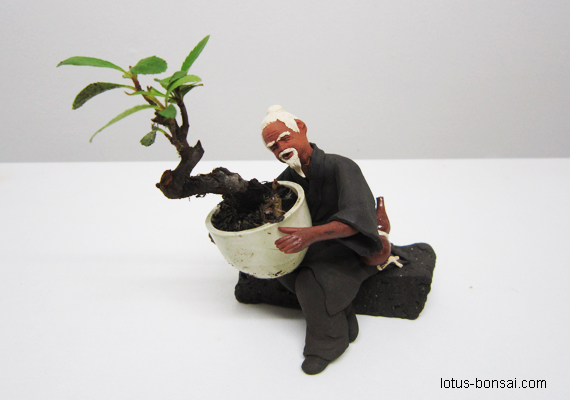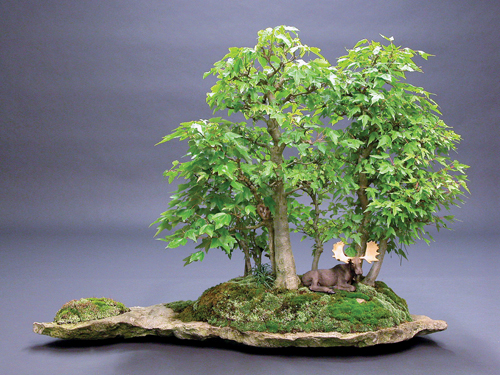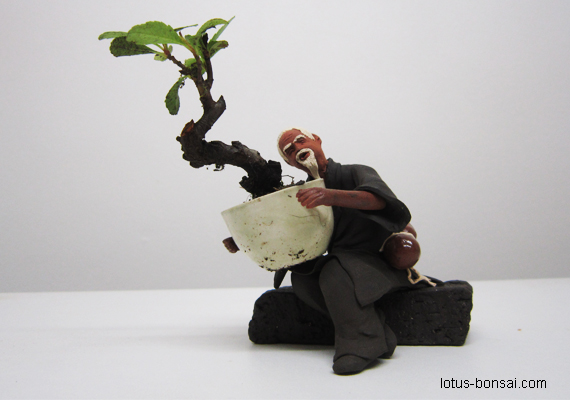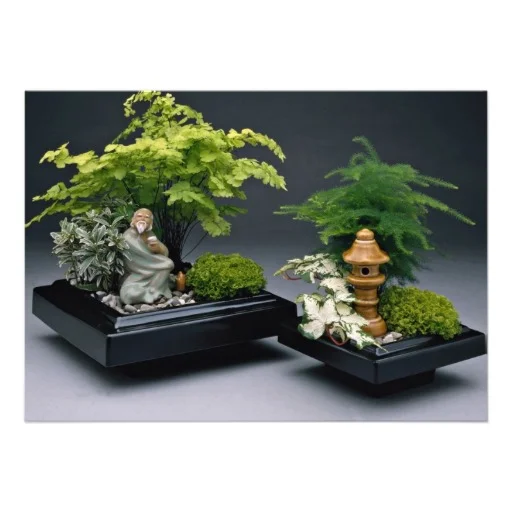Bonsai figures are miniature trees grown in containers, meticulously trained to mimic the shape and scale of full-sized trees. Bonsai is an ancient art form that originated in China and was later refined in Japan.
The practice involves cultivating small trees in containers, shaping them through pruning and wiring. These miniature trees can represent natural scenes, evoking a sense of tranquility and connection to nature. Bonsai enthusiasts dedicate significant time and effort to their craft, ensuring each tree looks balanced and aesthetically pleasing.
The art of bonsai combines horticulture and artistry, requiring patience, skill, and creativity. By understanding the principles of bonsai, individuals can appreciate the intricate beauty and cultural significance of these living sculptures.
History Of Bonsai
The history of Bonsai is long and fascinating. This ancient art form has evolved over centuries. It reflects the deep connection between humans and nature. Bonsai is not just about growing trees in pots. It is also about creating harmony and beauty in miniature.
Ancient Origins
The origins of Bonsai date back over 1,000 years. The practice began in China during the Han Dynasty. It was known as Penjing. Early Chinese monks brought Penjing to Japan. The Japanese then developed it into what we now call Bonsai.
Bonsai was initially practiced by the elite and nobility. It symbolized wealth and honor. Over time, the art spread to the general population. Today, Bonsai is enjoyed by people all over the world.
Cultural Significance
Bonsai has a deep cultural significance in Japan. It represents the harmony between nature and humans. Bonsai is often associated with Zen Buddhism. It teaches patience, care, and the beauty of imperfection.
In Japanese culture, Bonsai trees are often passed down through generations. They are treated as living family heirlooms. This practice connects the past, present, and future.
| Period | Significance |
|---|---|
| Han Dynasty | Origins in China as Penjing |
| Heian Period | Introduction to Japan by monks |
| Modern Day | Global practice and appreciation |
Bonsai is more than a hobby. It is a way of life. It teaches valuable lessons about nature and time.

Credit: lotusbonsaistudio.com
Types Of Bonsai Trees
Bonsai trees come in many shapes and sizes. Each type has its charm. Let’s explore some popular varieties and unique species of bonsai trees.
Popular Varieties
The most popular bonsai trees are easy to grow. They are perfect for beginners.
- Ficus Bonsai: This tree is hardy and forgiving. It can survive in low light.
- Chinese Elm: Known for its small leaves and strong trunk. It grows well indoors.
- Juniper Bonsai: A classic choice. It has needle-like leaves and requires bright light.
- Japanese Maple: Famous for its vibrant red and orange leaves. It needs a cool climate.
Unique Species
Some bonsai trees are unique. They offer something different and special.
- Baobab Bonsai: Known for its thick trunk. It thrives in warm climates.
- Bougainvillea Bonsai: This tree has bright flowers. It loves sunny spots.
- Sequoia Bonsai: A miniature version of the giant redwood. It needs ample space to grow.
- Wisteria Bonsai: Famous for its cascading flowers. It requires full sunlight.
| Bonsai Tree | Characteristics | Ideal Conditions |
|---|---|---|
| Ficus Bonsai | Hardy, forgiving | Low light |
| Chinese Elm | Small leaves, strong trunk | Indoor |
| Juniper Bonsai | Needle-like leaves | Bright light |
| Japanese Maple | Vibrant leaves | Cool climate |
| Baobab Bonsai | Thick trunk | Warm climate |
| Bougainvillea Bonsai | Bright flowers | Sunny spots |
| Sequoia Bonsai | Miniature redwood | Ample space |
| Wisteria Bonsai | Cascading flowers | Full sunlight |
Selecting Your Bonsai
Choosing the right bonsai is a fun journey. Each bonsai tree has its own charm. This guide helps you find the best bonsai for your home.
Choosing The Right Tree
There are many types of bonsai trees. Some are easy to care for, others need more attention. Start with a tree that fits your skill level.
- Juniper Bonsai: Great for beginners. It is hardy and easy to shape.
- Ficus Bonsai: Another beginner-friendly choice. It can grow in low light.
- Maple Bonsai: Beautiful but needs more care. It is perfect for intermediate growers.
Understanding Your Environment
Your environment plays a big role in bonsai care. Think about light, temperature, and humidity. Each tree type has its own needs.
| Tree Type | Light Needs | Temperature | Humidity |
|---|---|---|---|
| Juniper | Bright, indirect light | 60-75°F | Moderate |
| Ficus | Low to bright light | 65-75°F | Moderate |
| Maple | Bright light | 55-70°F | High |
Observe your home’s conditions. Then, choose a tree that thrives in that setup. This makes your bonsai care easier and more fun.

Credit: bonsaibark.com
Basic Bonsai Techniques
Mastering basic bonsai techniques is essential for creating beautiful bonsai figures. These techniques help control the growth and shape of your bonsai trees. Let’s explore some fundamental methods in bonsai care.
Pruning Basics
Pruning is vital for maintaining the desired shape of your bonsai. Start by removing dead branches and leaves. This promotes healthy growth and prevents disease.
Focus on cutting back new growth to keep the tree’s shape. Use sharp pruning shears for clean cuts. Aim to prune just above a node, where leaves or branches grow.
- Remove dead branches
- Cut back new growth
- Use sharp tools
- Prune above nodes
Wiring And Shaping
Wiring helps guide the growth of your bonsai tree. Use aluminum or copper wire for flexibility. Start by wrapping the wire around the trunk and branches.
Shape the tree by bending branches gently. Avoid wrapping too tightly to prevent damage. Keep the wire on for a few months until the branches hold their shape.
- Use aluminum or copper wire
- Wrap wire around trunk and branches
- Bend branches to desired shape
- Remove wire after a few months
By mastering these basic techniques, your bonsai tree will thrive and look beautiful.
Advanced Bonsai Skills
Mastering bonsai involves more than basic care. Advanced skills elevate your bonsai art. These skills include grafting and creating deadwood features. They add unique elements to your trees.
Grafting Techniques
Grafting techniques allow you to combine two plants. This creates a stronger, more beautiful tree. Here are some common grafting methods:
- Approach Graft: This method joins two growing plants. It’s great for beginners.
- Whip and Tongue Graft: This technique offers a strong union. It’s used for smaller branches.
- Cleft Graft: This method is good for thicker branches. It’s common in bonsai.
| Grafting Method | Difficulty Level | Best For |
|---|---|---|
| Approach Graft | Easy | Beginners |
| Whip and Tongue Graft | Moderate | Small Branches |
| Cleft Graft | Advanced | Thick Branches |
Creating Deadwood Features
Deadwood features add age and character to bonsai trees. They mimic natural wear and tear. Here’s how you can create stunning deadwood:
- Jin: Remove the bark from branches. This creates a weathered look.
- Shari: Strip the bark from the trunk. This simulates lightning strikes.
- Uro: Hollow out parts of the trunk. This gives an ancient feel.
Use specialized tools for deadwood creation. These include carving knives and pliers. Always work carefully to avoid damaging the tree.
Bonsai Care Essentials
Caring for a bonsai tree requires special attention and love. These miniature trees need specific conditions to thrive. Understanding the basics of bonsai care can make a huge difference. This section will cover the essentials to keep your bonsai healthy and beautiful.
Watering Guide
Proper watering is crucial for bonsai health. Too much or too little water can harm your tree. Follow these simple steps:
- Check the soil daily. It should be slightly damp, not dry.
- Water the bonsai thoroughly. Ensure water reaches the roots.
- Use a fine nozzle to avoid soil erosion.
- Water in the morning to prevent mold growth.
Remember, different bonsai species have unique needs. Adjust your watering schedule accordingly.
Fertilizing Tips
Fertilizing your bonsai provides essential nutrients. This helps the tree grow strong and healthy. Follow these tips to fertilize effectively:
- Use a balanced fertilizer with equal parts nitrogen, phosphorus, and potassium.
- Apply fertilizer every two weeks during the growing season.
- Reduce fertilization in winter when the tree is dormant.
- Always follow the instructions on the fertilizer package.
Over-fertilizing can damage your bonsai. It’s better to use less fertilizer than too much.
| Fertilizer Type | Frequency | Application Method |
|---|---|---|
| Liquid Fertilizer | Every two weeks | Mix with water and pour |
| Solid Fertilizer | Monthly | Place on soil surface |
Follow these bonsai care essentials for a thriving miniature tree. Proper watering and fertilizing will keep your bonsai healthy.
Seasonal Care
Taking care of bonsai figures requires attention to seasonal changes. Different seasons demand different care techniques. Understanding these techniques ensures your bonsai thrives throughout the year.
Spring And Summer
Spring is a time of growth. Your bonsai will need more water and nutrients. Check the soil daily to ensure it’s moist but not waterlogged.
- Water daily if the soil is dry.
- Use a balanced fertilizer every two weeks.
- Prune new growth to maintain shape.
Summer brings heat, so protect your bonsai from direct sunlight. Overexposure can damage the leaves and roots.
- Place your bonsai in partial shade.
- Increase watering frequency, possibly twice a day.
- Check for pests and treat immediately.
Fall And Winter
Fall is a time to prepare your bonsai for dormancy. Reduce watering and stop fertilizing to slow down growth.
- Water only when the soil is dry.
- Remove dead leaves and branches.
- Check root health and repot if necessary.
Winter requires protecting your bonsai from the cold. Some species need indoor care, while others can stay outside with proper protection.
| Indoor Care | Outdoor Care |
|---|---|
| Place near a sunny window. | Use mulch to insulate roots. |
| Keep away from drafts. | Cover with burlap or a frost cloth. |
| Water sparingly. | Water sparingly, ensuring soil is not frozen. |
By following these seasonal care tips, your bonsai will stay healthy and beautiful all year round.

Credit: lotusbonsaistudio.com
Displaying Your Bonsai
Displaying your bonsai is a rewarding part of the bonsai experience. It’s not just about growing a tree; it’s about creating a stunning display. This section will guide you through the essential aspects of showcasing your bonsai, including choosing a pot and creating a miniature landscape.
Choosing A Pot
Choosing the right pot is crucial for your bonsai’s beauty. The pot should complement the tree’s size and style.
- Size: The pot should be proportional to the tree. A small tree needs a small pot.
- Shape: Match the pot shape with the tree’s style. A round pot works well with softer lines.
- Color: The pot color should enhance the tree’s appearance. Neutral colors often work best.
A well-chosen pot can make your bonsai look more elegant and balanced.
Creating A Miniature Landscape
Creating a miniature landscape adds depth to your bonsai display. It turns a simple tree into a tiny world.
- Select Accessories: Use small rocks, moss, and tiny figurines. These elements add realism.
- Arrange Thoughtfully: Place rocks and moss naturally. Avoid cluttering the scene.
- Maintain Scale: Ensure all elements are proportional to the bonsai. This keeps the display cohesive.
Adding these elements can make your bonsai display more engaging and lifelike.
Remember, displaying your bonsai is an art. Each decision enhances its beauty and tells a story.
Conclusion
Bonsai figures can bring a touch of nature into any space. They offer tranquility and artistic expression. Whether you’re a beginner or an expert, bonsai figures provide endless enjoyment. Start your bonsai journey today and experience the beauty and serenity they bring.
Enjoy cultivating these living works of art.

